What are electrical panels?
Electrical distribution panels are an important part of an electrical installation that helps receive electrical power from a primary source to various circuits. The primary source is usually the power utility company or a generator. Electrical consultants for industries use electrical panels at a centralised location to easily control and protect the distribution system.
There are two types of panels- HT panel & LT panel. The electrical consultant recommends the panel based on the voltage to be distributed. The electrical load data helps in deciding the type of panel needed.
What are the differences between HT & LT electrical distribution panels?
Both HT and LT panels are for specific purposes. Electrical consultants design HT and LT panels to distribute electricity in different voltage ranges.
- Voltage Range: HT (High Tension) Panel handles over 1000 volts. HT Panels are typically recommended for distribution in HT systems like substations, power transmission systems and industries. Electrical consultants design LT Panels for the distribution of voltages up to 1000 Volts in residential, commercial and small-scale industries.
- Application: HT Panels are for step-up or step-down for transmission or distribution. These panels also come in use for high-voltage equipment. Whereas, LT panels primarily distribute to a localised area.
- Design and Components: The HT panel can withstand high voltage and currents. The components of the HT panel include insulated busbars and circuit breakers. In comparison, the LT panels are for lower voltage.
- Safety Considerations: The HT panels require additional safety features like interlocking systems, insulating barriers, and proper earthing system. These safety features help avoid electrical hazards and keep the working personnel safe. In contrast, LT panels have lesser safety risks. However, proper earthing and circuit protection are also parts of the LT panel.
The components of both HT Panels and LT panels must be as per the compliance and project requirements. The specifications for the panel in the tender must be according to the requirements.












